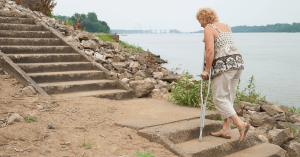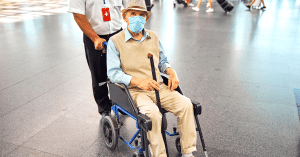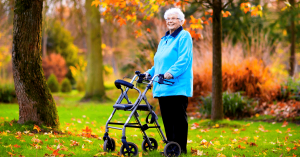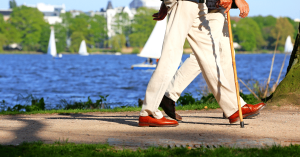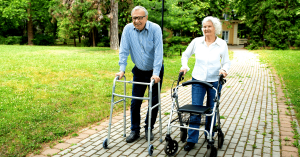
Imagine this…how great would it be if you could just try one of these tips every day…?
Within a few weeks you could have all 7 of these incredibly powerful strategies for easing neck pain working for you – giving you back the active and healthy lifestyle that you deserve.
Table of Contents
Toggle(1) Heat
Heat can be helpful for both relaxing tight, sore muscles and warming stiff, aching neck joints [1]. The heat encourages blood flow to the area, bringing oxygen and nutrients and removing waste products. This can help muscles to relax, loosen stiff joints and aid in the healing process.
A hot bath or hot shower can provide relief, as can many different heat aids; wheat bags that you can warm in the microwave and place over the shoulders are particularly nice for the neck. Plus all sorts of heat packs and wraps are available.
(2) Self massage
Neck pain can be influenced by tight, sore and painful muscles around the neck area [2]– especially those muscles running from the back and sides of your neck to the tops of the shoulder blades and the bony part on the tops of both shoulders (trapezius, levator scapulae, scalenes).
Usually sore muscles are due to the fact that they are tight, causing uncomfortable pulling sensations when you move your head. Tightness in a muscle (any muscle) is normally either because the muscle is weak and is struggling to handle the load it is being put under, or because it is working too hard to compensate for a muscle nearby that is weak and not doing its job properly.
Either way, relaxing these tight muscles through self massage techniques that you can do at home can give good temporary relief. I say temporary relief because you will also need to strengthen the weak muscles in order to get longer term, sustained improvements – see the exercise tips section for more on this!
Use your fingertips to gently work in circular motions into the shoulder muscles and up into the side of the neck.
A good way to reach tight, sore muscles further down around your shoulder blades is to put a tennis ball in a long sock (so you don’t keep dropping the ball!), hold onto the end of the sock, stand with a wall behind you and roll the ball around the muscles on the insides of your shoulder blades – this one feels great!
Another option is purchasing massage tools, both manual and electric. Long handled ones help you to reach areas you can’t easily reach yourself and can provide good relief.
The video below explains these ideas nicely.
(3) Exercises
The right sort of neck pain exercises are one of the most important things you can do to help with your neck pain [3]. If you don’t move for fear of pain or making things worse, you run the risk of potentially getting more stiff and more tight and therefore having more pain.
The best neck pain relief exercises to start with are gentle slow range of movement exercises to keep the neck moving in all directions. It’s important not to force this or move further than is comfortable for you, but to be slow and gentle about it so that your neck knows that it is safe to move – this will also help to oil any stiff joints.
The exercises shown in the video below are good, just try to do them more slowly!
Moving the muscles around your neck and shoulders regularly by rolling your shoulders or performing shoulder shrugs helps to loosen them up. The increased blood flow also helps to remove waste products like lactic acid from the tight knotted muscles, which can contribute to muscular pain.
For most benefit, these exercises should be done little and often throughout the day, as often as every hour, perhaps 5 or 10 of each one. But don’t forget to listen to your body and do what feels right for you – everybody’s different!
I like Yoga with Adriene for helpful, free yoga videos for everything you can think of, including neck and shoulder pain – like the one below:
If you are able to be more active, any form of movement, activity or exercise where you are moving your arms and shoulders will help to strengthen up the neck and shoulder area; whether it be swimming, gardening, playing with the kids, hoovering, baking, boxing, or any of thousands of options, these will all benefit you.
(4) Posture
Posture can have an influence on neck pain, especially if you are having to keep still for a prolonged period of time [4]. It is actually a lot harder and more challenging for our bodies to keep still than we give them credit for – because we are designed to move, not keep still!
For example, if you are having to sit at a desk for long periods without moving, the postural muscles of your neck and shoulders have to be strong in order to sustain this. Plus, the average human head weighs 5kg and as we crane our heads forwards to see our screens (mostly without even realising!) we are putting a tremendous strain on our neck muscles and crunching the joints in the back of our necks. This tension can also contribute to neck pain headaches.
Please see the video below for a good demonstration of this and for how to do the chin tuck exercise:
These ideas can be helpful, if you want to improve your posture:
–Chin tucks can encourage good head posture (see above video).
-Using a lumbar support or a rolled towel on your chair to support your lower back can have a knock-on effect on your posture higher up, so you are sitting up straighter and taller without having to force it.
-Alternatively, sitting on a gym ball instead of your usual chair for 30-60 minutes once or twice a day can encourage muscle activation, and you naturally have to sit up with better posture in order to stay stable! Aim for a 65-75cm ball for it to be big enough for this purpose.
-Imagine someone about to stick a pin in the front of your shoulder! Then just pull your shoulder back just a small amount to move it away from that pin. Do the same with the other shoulder. This is only a very small correction and doesn’t involve any forcing or squeezing or large movements but sets you up for good posture.
-Having an ergonomic assessment of your desk setup at work can also help and your company may be able to provide support with adjustments/adaptations if you’re struggling.
(5) Sleep
Are you struggling to sleep because of your neck pain? Or getting neck pain after sleeping? Not sleeping properly makes everything feel worse so try the following tips:
-Try a hot bath or shower before bed to relax your muscles
-Quite often when you have neck pain, having something more supportive under your head can help as your head can then relax a bit more [5]. For example, try a folded towel or two under your head instead of a soft pillow. The depth of your ‘pillow’ should be roughly equal to the distance from your neck to the furthest point of your shoulder – this ensures a neutral head position when sleeping on your side, so your head is not unnaturally tilted one way or the other.
There are some good tips and tricks you can try from the video below for how to sleep better with neck pain:
(6) Shoulder bag/backpack
Try to avoid carrying a bag on one shoulder if you can help it – the muscles that connect your neck and shoulder on that side will be overworking and tensing up slightly all the time to keep the bag in place. This can cause a lot of tension and tightness to build up in those muscles, contributing to neck pain on one side.
Instead, try to wear a backpack or similar bag that distributes the load equally across your back and both shoulders, so that your neck and shoulder muscles can relax. Then you are less likely to get neck pain on the left side or the right side!
Even better is if you can get a backpack with a chest strap and /or hip belt; the chest strap means that your shoulder muscles can fully relax without the backpack straps sliding off your shoulders. The hip belt helps you to take more load through your hips rather than through your shoulders, again so you are not overburdening those neck and shoulder muscles.
See the backpack ergonomics infographic below to get an idea of this:

(7) Give physiotherapy a try
-A Physiotherapist can assess you and your neck one to one and provide a diagnosis. An assessment will usually involve:
- Asking questions about you and your neck pain to get to know you
- Having a look at your neck and shoulders, your posture and the way that you move
- Checking how much neck movement you have and what seems to be restricting it (if anything)
- Having a feel of your neck and shoulders to see if there is stiffness or tightness present
- Checking how strong your muscles are
-They will also be able to treat you to help you get better based on what they find. This may include:
- Massage therapy to relax tight sore muscles and relieve neck pain from stress.
- Joint mobilisation techniques to ease stiffness (no more neck pain turning your head)
- Exercise therapy to help restore range of movement and strengthen muscles
-They will be able to give you advice and answer any questions you might have about your neck.
-They will also be able to provide you with a personalised exercise programme for you to do based on your assessment, as everyone’s neck is different!
Neck pain frequently asked questions
Yes, but it’s rare.
Most musculo-skeletal aches and pains get better within six to eight weeks. Even if it carries on for longer, it doesn’t necessarily mean that it’s something more serious.
But it’s important that you know when to seek help. If you experience any of the following you should contact your GP/Doctor:
- The pain you are experiencing is getting worse rather than better, despite following self care advice or advice from a health care professional
- Your symptoms have not been helped by trying medication
- You feel generally unwell and have symptoms such as fever, night sweats or weight loss
- You experience pain at night (possibly worse than during the day), that prevents you from sleeping due to increasing pain and/or difficulty lying flat
- You experience a change in your ability to walk, including balance problems or weakness/heaviness in your arms or legs
- lack of coordination e.g. trouble with tasks like buttoning a shirt
- pins and needles in an arm, as well as pain
- loss of bladder or bowel control
- you develop a hot and swollen joint for no apparent reason
- early morning stiffness, lasting for longer than 30 minutes
- new on-set severe headache
Taken from the Chartered Society of Physiotherapy’s ‘Managing Your Neck Pain’ page here.
Yes, for two reasons.
- Neck pain can affect the way the sub-occipital muscles work, which are the muscles that run between the upper neck and the base of the skull. These muscles have an influence on dizziness and balance because they contain lots of receptors that help the brain know what the position of the head is. If you have neck pain, you may be moving your head less, or differently. Which will affect the messages that the muscles are sending to the brain.
- There are blood vessels that run up the neck (very close to the neck bones) and connect to the balance part of the brain (the cerebellum). If you have neck pain, stiffness or arthritis of the neck joints could potentially affect these blood vessels and therefore the balance systems of the brain.
Yes.
The neck and head have a lot of connecting structures, so neck pain can cause headaches and, likewise, headaches can cause neck pain.
There are two main types of head pain caused by a neck problem:
- Cervicogenic headache – referred pain (a pain in the neck that you feel in your head), usually coming from the neck joints or discs.
- Occipital neuralgia – the occipital nerves (the nerves that run through the scalp) are injured or inflamed (a pinched nerve).
Cervicogenic headache and occipital neuralgia can present with similar symptoms, so it’s hard to know which one it is unless you see a specialist.
So, there you have it: 7 things that you can do today to ease your neck pain as well as improve your posture and general neck health.
There are so many little things you can do yourself that can help you to get better and feel better!
Good luck with trying them out!
What to do next?
If you want to know more about physiotherapy and how it can help you, check out ‘what is physiotherapy and will it help me get better?’.
References
[1] Shin HJ, Kim SH, Hahm SC, Cho HY. Thermotherapy Plus Neck Stabilization Exercise for Chronic Nonspecific Neck Pain in Elderly: A Single-Blinded Randomized Controlled Trial. Int J Environ Res Public Health. 2020 Aug 1;17(15):5572.
[2] Borisut S, Tantisuwat A, Gaogasigam C. The study of respiratory muscles activation during respiratory muscle strength effort in adult females with chronic neck pain. J Phys Ther Sci. 2021 Sep;33(9):689-694
[3] Chris Worsfold (2020) Functional rehabilitation of the neck, Physical Therapy
Reviews, 25:2, 61-72
[4] Baradaran Mahdavi S, Mazaheri-Tehrani S, Riahi R, Vahdatpour B, Kelishadi R. Sedentary behavior and neck pain in children and adolescents; a systematic review and meta-analysis. Health Promot Perspect. 2022 Dec 10;12(3):240-248
[5] Ahmed Radwan, Nicholas Ashton, Trever Gates, Austin Kilmer, Michael VanFleet,
Effect of different pillow designs on promoting sleep comfort, quality, & spinal alignment: A systematic review, European Journal of Integrative Medicine,
Volume 42, 2021.



